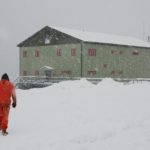Note: This instrument was temporarily moved to Rothera in 2017. Up on the roof of the science module is an instrument that looks a bit like some kind of anti-aircraft gun. It’s a sky radiometer: an instrument that measures the extent to which light from the Sun is scattered as it travels through the Earth’s atmosphere.
This allows us to calculate the size and density of the particles that are scattering the light (mainly things like sea salt, volcanic dust and man-made pollutants).
This scattering effect can vary – for example following a large volcanic eruption – and can have a major effect on climate by altering how much of the Sun’s radiation reaches the surface and how much is trapped once it gets there.
The POM is part of a network of similar instruments around the world. As the air at Halley is much less polluted than in more populous parts of the world, it provides a really useful comparison.

